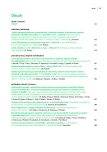Infective endocarditis in Tabor district in years 2009–2013
Authors:
Rudolf Koubek
Authors‘ workplace:
Interní oddělení II – kardiologie, Nemocnice Tábor, a. s., Tábor, primář MUDr. Rostislav Král
Published in:
Vnitř Lék 2014; 60(10): 827-831
Category:
Original Contributions
Overview
Aim:
To find out an average incidence of infective endocarditis (IE) in Tabor district in a monitored period of time and compare the obtained data with previously published national study.
Methods:
Retrospective monocentric observational study monitoring occurence and characteristics of infective endocarditis in a defined region in years 2009–2013. Only patients with proved and treated infective endocarditis and patients whose diagnosis was revealed by autopsy were involved.
Results:
In the monitored time 39 cases of infective endocarditis occured, which means that the average incidence was 7.8 cases on 100 000 people per year. Median age in the time of diagnosis was 67. The group of patients was strongly dominated by men, who were affected three times more often than women. Almost the same rates of infective endocarditis were localized on mitral (36 %) and aortic (33 %) valve and electrode of a pacemaker (31 %). In comparison with the reference study there were more pacemaker-related infections detected. Two thirds of infections were caused by staphylococci. That means a prominent growth when compared to the pilot study. On the contrary, there was no significant change in mortality.
Conclusion:
Characteristic features of infective endocarditis are evolving, patients’ in-hospital mortality rate is high, about 30 %. The disease by itself is a poor prognostic factor in a one-year mortality rate.
Key words:
incidence infective – infective endocarditis
Sources
1. Beneš J, Gregor P, Mokráček A. Infekční endokarditida. Doporučené postupy diagnostiky, léčby, dispenzarizace a profylaxe. Cor Vasa 2007; 49(6): K157–171 a Supplementum Cor Vasa 2007; 49(11): 106–120.
2. Vojáček J, Kettner J. Klinická kardiologie. Nucleus HK: Hradec Králové 2009. ISBN 978–80–87009–58–1.
3. Beneš J, Baloun R, Džupová O. Endokarditidy 2007: výsledky multicentrické studie o výskytu a vlastnostech infekční endokarditidy. Vnitř Lék 2011; 57(2): 147–154.
4. Slipczuk L, Codolosa JN, Davila CD et al. Infective Endocarditis Epidemiology Over Five Decades: A Systematic Review. PLoS One 8(12): e82665. Dostupné z DOI: <http://doi:10.1371/journal.pone.0082665>.
5. Pazdernik M, Baddour LM, Pelouch R. Infective endocarditis in the Czech Republic: eight years experience at one of the country’s largest medical centers. J Heart Valve Dis 2009; 18(4): 395–400.
6. Beneš J, Kabelková M, Džupová O et al. Infekční endokarditida – pacienti hospitalizovaní na Infekční klinice Fakultní nemocnice Bulovka v letech 1990–1999. Cor Vasa 2000; 42(8): 389–396.
7. Baddour LM, Wilson WR, Bayer AS et al. Infective endocarditis. Diagnosis, antimicrobial therapy, and management of complications. AHA scientific statement. Circulation 2005; 111(23): e394-e433. Erratum in Circulation 2007; 116(21): e547. Circulation.2008; 118(12): e497. Circulation. 2007; 115(15): e408. Circulation. 2005; 112(15):2373.
8. Li JS, Sexton DJ, Mick N et al. Proposed modifications to the Duke criteria for the diagnosis of infective endocarditis. Clin Infect Dis 2000; 30(4): 633–638.
9. Le KY, Sohail MR, Friedman PA et al. Mayo Cardiovascular Infections Study Group. Clinical Features and Outcomes of Cardiovascular Implantable electronic Device Infections Due to Staphylococcal Species. Am J Cardiol 2012; 110(8): 1143–1149.
10. Moreillon P, Que YA. Infective endocarditis. Lancet 2004; 363(9403): 139–149.
Labels
Diabetology Endocrinology Internal medicineArticle was published in
Internal Medicine

2014 Issue 10
Most read in this issue
- Optimal way of administration of high dose intravenous furosemide – continuous infusion or bolus?
- Therapeutic monitoring of vancomycin in routine clinical practice
- Monoclonal gammopathy of undetermined significance and asymptomatic multiple myelom in the year 2014
- Gout and cardiovascular risk
